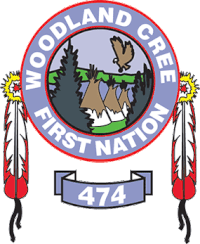
The Cree or nehinaw are a North American Indigenous people. They live primarily in Canada, where they form one of the country's largest First Nations. More than 350,000 Canadians are Cree or have Cree ancestry. The major proportion of Cree in Canada live north and west of Lake Superior, in Ontario, Manitoba, Saskatchewan, Alberta, and the Northwest Territories. About 27,000 live in Quebec.
First Nations in Alberta are a group of people who live in the Canadian province of Alberta. The First Nations are peoples recognized as Indigenous peoples or Plains Indians in Canada excluding the Inuit and the Métis. According to the 2011 Census, a population of 116,670 Albertans self-identified as First Nations. Specifically there were 96,730 First Nations people with registered Indian Status and 19,945 First Nations people without registered Indian Status. Alberta has the third largest First Nations population among the provinces and territories. From this total population, 47.3% of the population lives on an Indian reserve and the other 52.7% live in urban centres. According to the 2011 Census, the First Nations population in Edmonton totalled at 31,780, which is the second highest for any city in Canada. The First Nations population in Calgary, in reference to the 2011 Census, totalled at 17,040. There are 45 First Nations or "bands" in Alberta, belonging to nine different ethnic groups or "tribes" based on their ancestral languages.

The Enoch Cree Nation #440 is a First Nations band government in Alberta, Canada. Members of the Nation are of Cree ancestry and speak the Plains Cree dialect of the Cree language group. The band is a signatory of Treaty 6 and is a member of the Confederacy of Treaty Six First Nations. The chief of the Enoch Cree Nation is Cody Thomas.
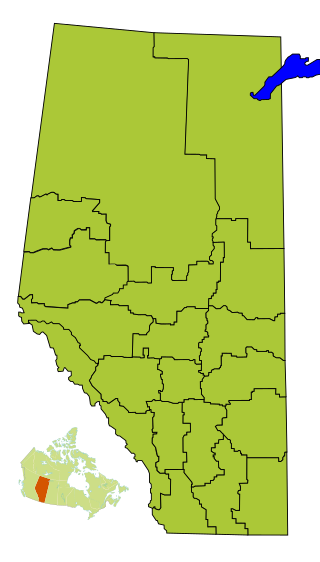
Division No. 17 is a census division in Alberta, Canada. It spans the central and northwest portions of northern Alberta and its largest urban community is the Town of Slave Lake. Division No. 17 is the largest census division in Alberta according to area and also has the lowest population density.

The Bigstone Cree Nation is a First Nations band government in Alberta, Canada. As Woodland Cree, they are a western branch of the larger Cree nation, and are a party to Treaty 8 with Canada. The Bigstone Cree Nation was divided into two bands in 2010, with one group continuing under the former name, and the other becoming the Peerless Trout First Nation.
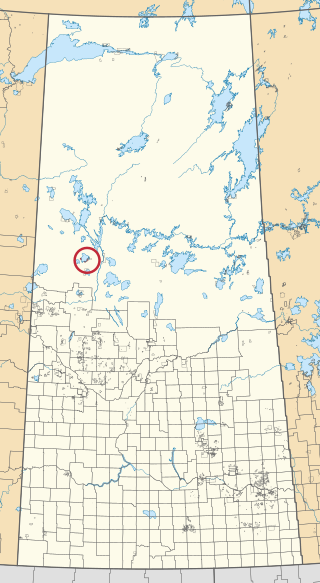
Canoe Lake 165 is an Indian reserve of the Canoe Lake Cree First Nation in the boreal forest of northern Saskatchewan, Canada. Its location is on Canoe Lake approximately thirty miles west of Beauval, within the ancient hunting grounds of the Woodland Cree. In the 2016 Canadian Census, it recorded a population of 912 living in 250 of its 273 total private dwellings. In the same year, its Community Well-Being index was calculated at 53 of 100, compared to 58.4 for the average First Nations community and 77.5 for the average non-Indigenous community. The reserve includes the settlement of Canoe Narrows. The name of the reserve and the settlement in Cree is nêhiyaw-wapâsihk ᓀᐦᐃᔭᐤ ᐘᐹᓯᕽ.

Ahtahkakoop First Nation is a Cree First Nation band government in Shell Lake, Saskatchewan, Canada belonging to the Wāskahikaniwiyiniwak division of nēhiyawak. The Ahtahkakoop First Nation government and community is located on Ahtahkakoop 104, 72 kilometers northwest of Prince Albert and is 17,347 hectares in size. The community was formerly known as the "Sandy Lake Indian Band", a name which is still used interchangeably when referring to the reserve.
Ermineskin Cree Nation also known as the Ermineskin Tribe, is a Cree First Nations band government in Alberta, Canada. A signatory to Treaty 6, Ermineskin is one of the Four Nations of Maskwacis, Alberta's largest Indigenous community.
The following is an alphabetical list of topics related to Indigenous peoples in Canada, comprising the First Nations, Inuit and Métis peoples.

The Sturgeon Lake Cree Nation is a First Nations band government or "band", part of the Cree ethnic group, a member of the Western Cree Tribal Council, and a party to Treaty 8. The band controls three Indian reserves, the large Sturgeon Lake 154 and the smaller 154A and 154B. It is based on the shores of Sturgeon Lake, around Calais, west of Valleyview, in the M.D. of Greenview in the Peace Country of Northern Alberta. The registered population of the band is 3,064, of those 1,407 are on the band's own reserves.
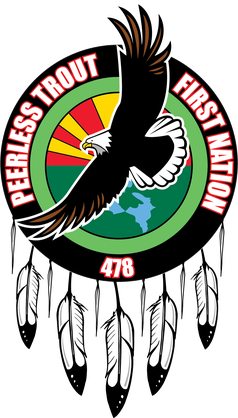
The Peerless Trout First Nation is a First Nations band government in northern Alberta, Canada, that is based out of Peerless Lake. It is part of the Treaty 8 Confederacy and was formed as Alberta's forty-fifth First Nation in 2010.
Saddle Lake Cree Nation is a Plains Cree, First Nations community, located in the Amiskwacīwiyiniwak region of central Alberta, Canada. The Nation is a signatory to Treaty 6, and their traditional language is Plains Cree.

Mikisew Cree First Nation is an Indigenous First Nations government of Woodland Cree people in northeastern Alberta and in Northwest Territories, Canada.

Peepeekisis Cree Nation (Cree: ᐲᐦᐲᑭᓰᐢ, pîhpîkisîs, literal meaning: Sparrow Hawk) is a Cree First Nation in southern Saskatchewan, Canada. Its reserves include Peepeekisis 81; Treaty Four Reserve Grounds 77, which is shared with 32 other bands; and Peepeekisis Cree Nation, which is located 19 km (12 mi) east of Balcarres, Saskatchewan, on Highway 10.

Woodland Cree 226 is an Indian reserve of the Woodland Cree First Nation in Alberta, located within Northern Sunrise County. It is 48 kilometres northeast of Peace River. In the 2016 Canadian Census, it recorded a population of 723 living in 188 of its 211 total private dwellings.
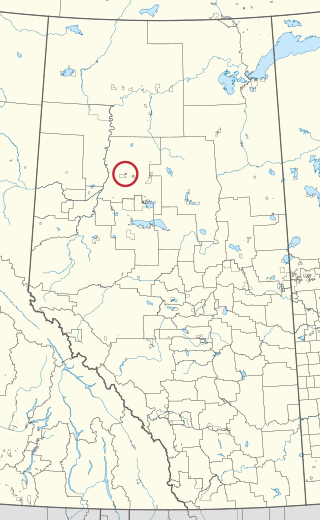
Woodland Cree 227 is an Indian reserve of the Woodland Cree First Nation in Alberta, located within Northern Sunrise County. It is 60 kilometres northeast of Peace River.

Woodland Cree 228 is an Indian reserve of the Woodland Cree First Nation in Alberta, located within Northern Sunrise County. It is 75 kilometres northeast of Peace River. In the 2016 Canadian Census, it recorded a population of 150 living in 33 of its 36 total private dwellings.
The Swan River First Nation is a Woodland Cree First Nations band government in northern Alberta. Located on the south-central shore of Lesser Slave Lake near Kinuso, it controls two Indian reserves, Swan River 150E and Assineau River 150F.
